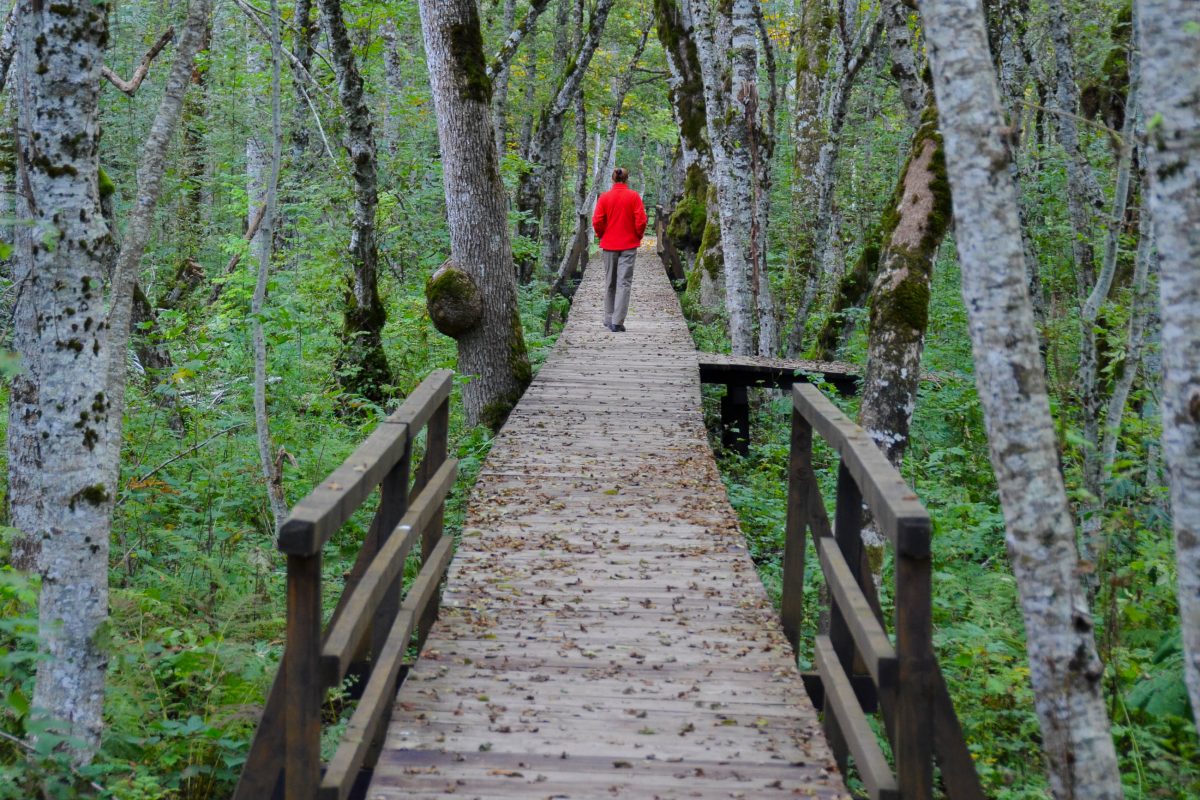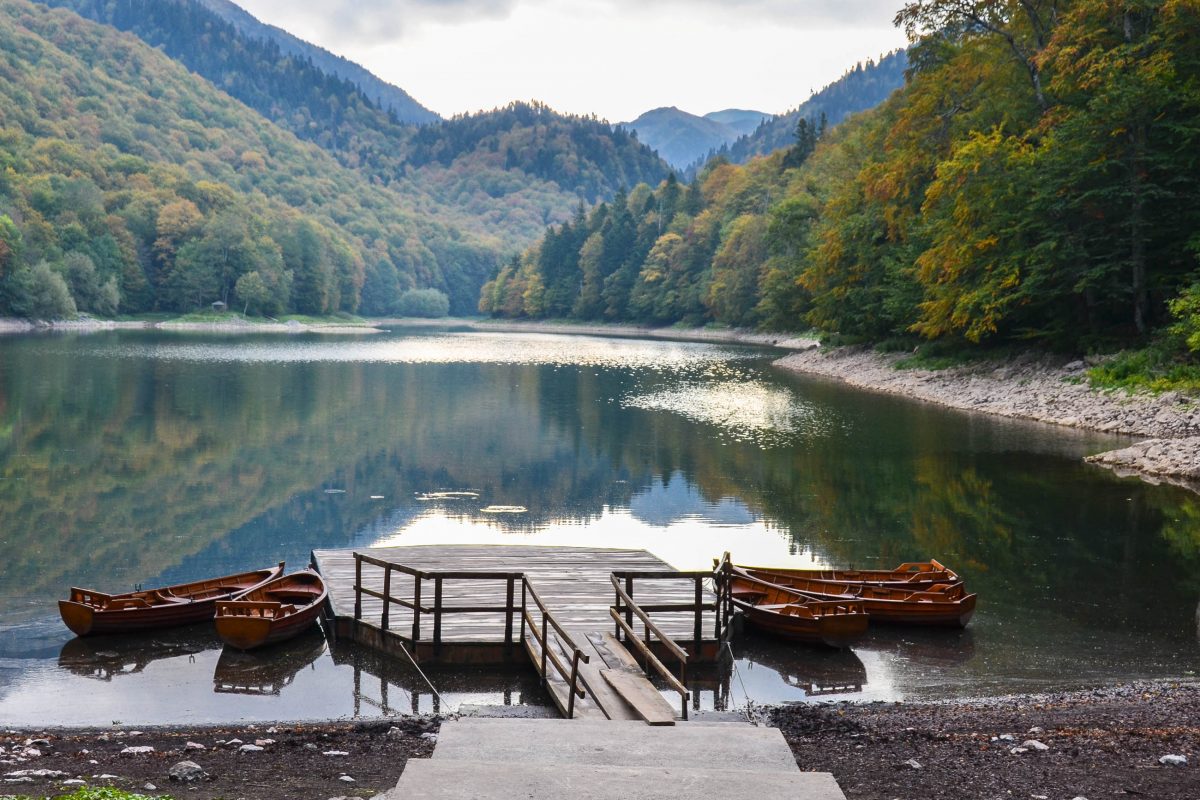Der Biogradska Gora Nationalpark liegt im Herzen der montenegrinischen Bjelascia-Bergkette und beherbergt neben einer unglaublichen Artenvielfalt und stillen Gletscherseen einen der letzten Urwälder Europas.
Der Biogradska Gora Nationalpark im Osten Montenegros ist mit einer Fläche von knapp 60 Quadratkilometern zwar der kleinste Nationalpark des Landes, kann aber dennoch mit einer vielfältigen Tier- und Pflanzenwelt und spektakulären landschaftlichen Highlights aufwarten. Seine Landschaft ist von uralten Wäldern, rauschenden Gebirgsbächen, bis zu 2.000 Meter hohen Bergen, blühenden Almwiesen und eiskalten Gletscherseen geprägt.
Gemeinsam mit dem Nationalpark Belaweschskaja Puschtscha im Westen Weißrusslands und dem Perućica-Urwald im Sutjeska-Nationalpark in Bosnien-Herzegowina beherbergt der Biogradska Gora Nationalpark den letzten richtigen Urwald Europas. Das ursprüngliche Naturjuwel zählt zu unseren Top 10 Sehenswürdigkeiten in Montenegro.
Die Artenvielfalt dieses Gebietes wurde bereits im Jahr 1878 das erste Mal von König Nikola I. unter Schutz gestellt – nur 14 Jahre nachdem mit dem Yellowstone-Park in den USA der erste Nationalpark der Welt gegründet wurde. Der Biogradska Gora wurde dann 1952 zum Nationalpark erklärt.
Inhaltsverzeichnis
BILDER: Wanderweg um den Biogradsko Jezero
Fotogalerie: Wanderweg um den Biogradsko Jezero
Wie kommt man zum Biogradska Gora Nationalpark?

Der Biogradska Gora Nationalpark liegt etwa 100km nördlich von Podgorica, die nächstgelegene Ortschaft ist Kolašin, wo es auch Unterkunftsmöglichkeiten gibt. Eine Abzweigung in den Nationalpark führt etwas nördlich von Kolašin durch das Tara-Tal bis zur Hütte der Parkverwaltung am Ufer des Biogradsko Jezero. Hier befinden sich außerdem ein Restaurant und einige Holzhütten mit Gästezimmern. Für den Besuch des Nationalparks wird eine geringe Gebühr eingehoben.
Tipp: Wer nicht mit dem eigenen Auto unterwegs ist, kann den Bus von Kolašin oder Mojkovac aus nehmen, die auch ans Eisenbahnnetz angeschlossen sind. Er hält an der Hauptstraße, von wo man nach etwa einer Stunde Fußmarsch am Biogradsko Jezero ankommt.
Vom Ufer des Biogradsko Jezero führt eine Forststraße weiter nach oben zu den Regionen um Zekova Glava und Crna Glava. Dort, auf über 2.000 Metern Seehöhe, ist ein weitläufiges Netz aus Wanderwegen zu finden, das allerdings eher konditionsstarken Urlauber vorbehalten ist.
Die wenigen Touristen im Biogradska Gora Nationalpark verteilen sich schnell und so kann es schon vorkommen, dass man ganz allein auf einem Berggipfel steht, nur begleitet vom ständigen Summen der Insekten.
Tipp: Wer ein Allradfahrzeug besitzt, kann beginnend bei der Forststraße beim Ufer des Biogradsko Jezero eine faszinierende ca. 30 Kilometer lange Rundreise auf über 2.000 Metern rund um den Nationalpark unternehmen. Man wird mit einmaligen landschaftlichen Highlights belohnt. Informationen dazu am besten in der Hütte der Parkverwaltung einholen.
BILDER: Allrad-Rundfahrt durch den Biogradska Gora Nationalpark
Fotogalerie: Allrad-Rundfahrt durch den Biogradska Gora Nationalpark
Sehenswertes im Biogradska Gora Nationalpark

Der Nationalpark ist vor allem für seine ursprünglichen Wälder bekannt, in denen eine fantastische Tier- und Pflanzenwelt heimisch ist. In den 26 verschiedenen Ökosystemen des Parks leben 150 verschiedene Vogel- und 350 Insektenarten, zu den größten Säugetieren zählen Bären und Rothirsche.
Wie zufällig im Nationalpark verstreut stößt der Wanderer auch immer wieder auf Berghütten, so genannte „katuns“, alte Häuser, verlassene Türme und historische Wassermühlen, die alle ihre eigene Geschichte erzählen.
Tipp: Um die Schönheit des Biogradska Gora Nationalparks in all ihren Facetten zu erforschen, benötigt man etwa drei Tage.
Gletschersee Biogradsko Jezero

Der tiefblaue Biogradsko Jezero ist der größte der sechs Gletscherseen im Nationalpark. Er befindet sich in einem rund 10km langen Seitental der Tara. Der langgestreckte See ist nur bis maximal 6m tief, liegt auf einer Höhe von gut 1.000 Metern und begrüßt die Besucher, die den Eingang zum Park passieren.
Umringt wird der Biogradsko Jezero von einigen der ältesten Bäume Europas. Die Rotbuchen, Ahornbäume und Eschen sind an die 45 Meter hoch und bis zu 500 Jahre alt. Die Urwälder können auf dem bequemen, 3,5km langen Wanderweg erkundet werden, der um den See führt und zur Hochsaison meist stark von Urlaubern frequentiert ist.
Von einem 21m hohen Aussichtsturm aus, der von der Austrian Development Agency errichtet und 2009 eröffnet wurde, kann die malerische Szenerie des Gletschersees überblickt werden.
Weiterführende Links:





